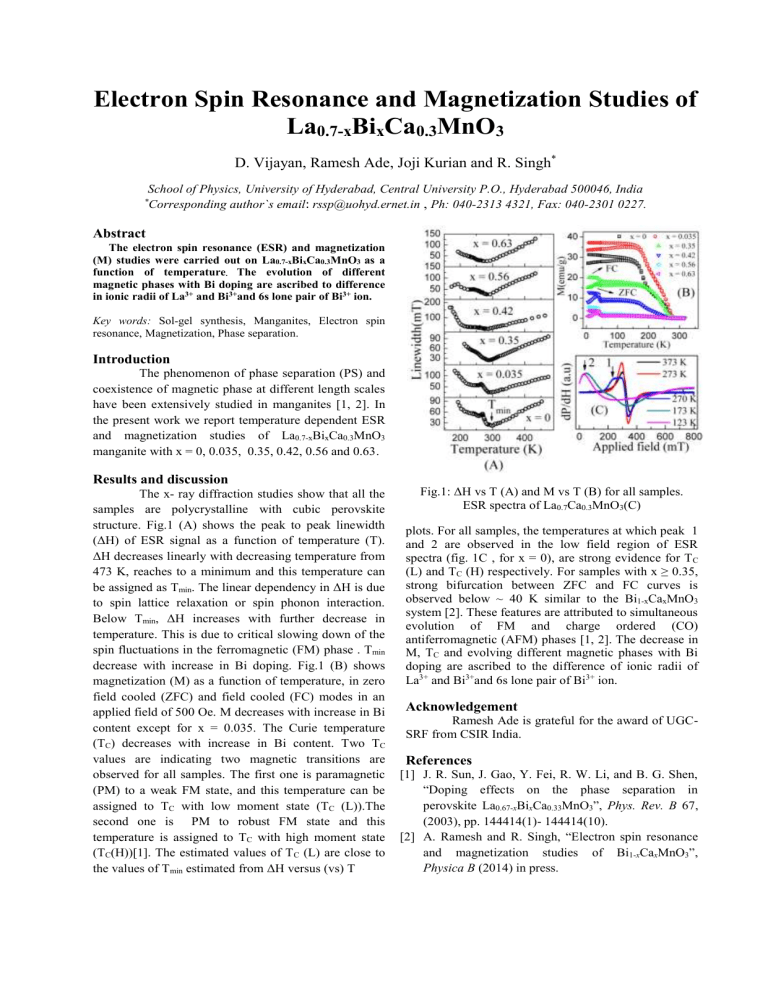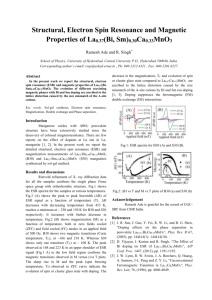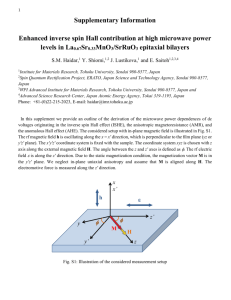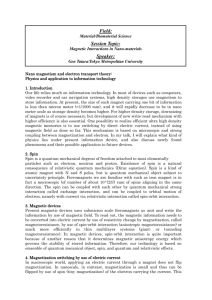View

Electron Spin Resonance and Magnetization Studies of
La
0.7-x
Bi
x
Ca
0.3
MnO
3
D. Vijayan, Ramesh Ade, Joji Kurian and R. Singh
*
Abstract
School of Physics, University of Hyderabad, Central University P.O., Hyderabad 500046, India
* Corresponding author`s email : rssp@uohyd.ernet.in
, Ph: 040-2313 4321, Fax: 040-2301 0227.
The electron spin resonance (ESR) and magnetization
(M) studies were carried out on La
0.7-x
Bi x
Ca
0.3
MnO
3 as a function of temperature
.
The evolution of different magnetic phases with Bi doping are ascribed to difference in ionic radii of La 3+ and Bi 3+ and 6s lone pair of Bi 3+ ion.
Key words: Sol-gel synthesis, Manganites, Electron spin resonance, Magnetization, Phase separation.
Introduction
The phenomenon of phase separation (PS) and coexistence of magnetic phase at different length scales have been extensively studied in manganites [1, 2]. In the present work we report temperature dependent ESR and magnetization studies of La
0.7-x
Bi x
Ca
0.3
MnO
3 manganite with x = 0, 0.035, 0.35, 0.42, 0.56 and 0.63.
Results and discussion
The x- ray diffraction studies show that all the samples are polycrystalline with cubic perovskite structure. Fig.1 (A) shows the peak to peak linewidth
(ΔH) of ESR signal as a function of temperature (T).
ΔH decreases linearly with decreasing temperature from
473 K, reaches to a minimum and this temperature can be assigned as T min
. The linear dependency in ΔH is due to spin lattice relaxation or spin phonon interaction.
Below T min
, ΔH increases with further decrease in temperature. This is due to critical slowing down of the spin fluctuations in the ferromagnetic (FM) phase . T min decrease with increase in Bi doping. Fig.1 (B) shows magnetization (M) as a function of temperature, in zero field cooled (ZFC) and field cooled (FC) modes in an applied field of 500 Oe. M decreases with increase in Bi content except for x = 0.035. The Curie temperature
(T
C
) decreases with increase in Bi content. Two T
C values are indicating two magnetic transitions are observed for all samples. The first one is paramagnetic
(PM) to a weak FM state, and this temperature can be assigned to T
C
with low moment state (T
C
(L)).The second one is PM to robust FM state and this temperature is assigned to T
C
with high moment state
(T
C
(H))[1]. The estimated values of T
C
(L) are close to the values of T min
estimated from ΔH versus (vs) T
Fig.1: ΔH vs T (A) and M vs T (B) for all samples.
ESR spectra of La
0.7
Ca
0.3
MnO
3
(C) plots. For all samples, the temperatures at which peak 1 and 2 are observed in the low field region of ESR spectra (fig. 1C , for x = 0), are strong evidence for T
C
(L) and T
C
(H) respectively. For samples with x ≥ 0.35, strong bifurcation between ZFC and FC curves is observed below ~ 40 K similar to the Bi
1-x
Ca x
MnO
3 system [2]. These features are attributed to simultaneous evolution of FM and charge ordered (CO) antiferromagnetic (AFM) phases [1, 2].
The decrease in
M, T
C
and evolving different magnetic phases with Bi doping are ascribed to the difference of ionic radii of
La 3+ and Bi 3+ and 6s lone pair of Bi 3+ ion.
Acknowledgement
Ramesh Ade is grateful for the award of UGC-
SRF from CSIR India.
References
[1] J. R. Sun, J. Gao, Y. Fei, R. W. Li, and B. G. Shen,
“Doping effects on the phase separation in perovskite La
0.67x
Bi x
Ca
0.33
MnO
3
”, Phys. Rev. B 67,
(2003), pp. 144414(1)- 144414(10).
[2] A. Ramesh and R. Singh, “Electron spin resonance and magnetization studies of Bi
1x
Ca x
MnO
3
”,
Physica B (2014) in press.











